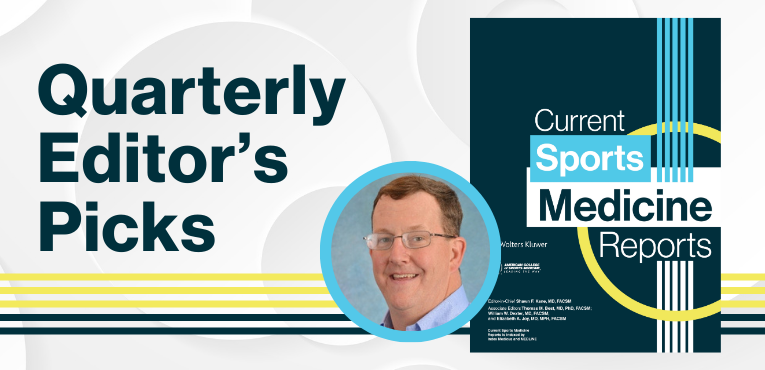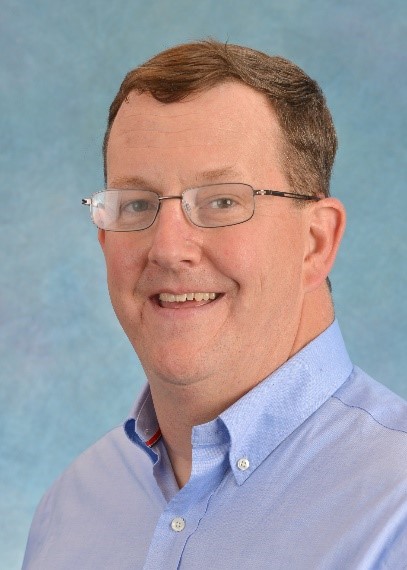by
Caitlin Kinser
| Apr 16, 2024
 Welcome to the highlights and the review of the AWESOME case reports and section articles published over the last quarter in Current Sports Medicine Reports (CSMR). We are going to start with some interesting and educational case reports that were published. Case reports are a great way to learn whether a condition is rare or uncommon or just a different presentation of a common problem.
Welcome to the highlights and the review of the AWESOME case reports and section articles published over the last quarter in Current Sports Medicine Reports (CSMR). We are going to start with some interesting and educational case reports that were published. Case reports are a great way to learn whether a condition is rare or uncommon or just a different presentation of a common problem.
I would like to highlight three not-to-be-missed cases from the past quarter:
Proximal Muscle Weakness in a Collegiate Volleyball Player submitted by Granley and Vidlock. This case to me highlights the need to always have a broad differential as you cannot diagnose what you don’t know. Getting a thorough history and cataloging all the symptoms led to a very thorough workup and a diagnosis of dermatomyositis, a very uncommon idiopathic myopathy. A great part of this case is the authors highlight the updated clinical decision tool, so if you have a similar case you can reference this tool to help with the diagnosis.
Penetrating Flank Injury in an Adolescent Due to Exercise Resistance Band Malfunction submitted by Ruzga and Gorra. This crazy case is an example of something that you couldn’t recreate if you tried. What are the chances of a metal carabiner snapping off, flying through the air, and penetrating the skin and ending up in the peritoneum? I wanted to highlight this case report to emphasize the risks associated with home exercise and kids – 12,000 ER visits a year!! I never gave a second thought to the dangers of resistance bands. Be careful.
Psoas Abscess in a Snowboarder: A Musculoskeletal Manifestation of Crohn’s Diseasesubmitted by Dennis, et al. This case to me highlights the importance of the Primary Care aspect of Primary Care Sports Medicine. A thorough review of prior treatments and the history along with a detailed current physical examination helped identify the etiology of the pain. If you haven’t already, look at the images of the pathology -- clearly not at all like the other side.
We also have awesome section articles that cover a variety of areas, and I would like to highlight three from the past quarter:
Nasal Injuries and Issues in Athletes submitted by Escalona and Okamura. This is an awesome review of the anatomy and the role the nose plays in respiratory function. The authors provide a very thorough and concise review of the medical and traumatic causes of nose pathology. If you cover combat sports and need a refresher on nose bleeds and fractures, this is a great place to look. I recently had a case of a middle school softball player who fielded a well-hit ground ball with her nose and not the glove. It was an impressive comminuted nasal fracture that ENT fixed quickly and you wouldn’t even know it happened. If only I could fix her concussion as quickly.
A Critical Review of Existing Evidence-Based Sport Psychological Interventions for College Athletes with Comorbid Attention Deficit-Hyperactivity Disorder and Sport-Related Concussions submitted by Davis, et al. Multifactorial conditions require multidisciplinary solutions. This article highlights and summarizes the role and the unique skill set of sports psychologists and how they can be instrumental in optimizing the treatment of athletes. While it focuses mainly on the intersection of sports-related concussion and ADHD, clearly there is a significant added benefit. I am a big believer in sports medicine is a team sport and bringing to bear the maximum skill set of every team member will provide the best outcomes.
Legg-Calve-Perthes Disease: Diagnosis, Decision Making and Outcome submitted by Ng, et al. Maybe because I have started my preparation to take the CAQ exam (again this will be the 3rd time) this article struck me as perfect. It is an OUTSTANDING review article on the pathology, risk factors, presentation, physical exam, and management. The tables are great as are the images. This article will help you handle the 4 to 8-year-old who presents with a progressing limp with or without pain. Anyone up for authoring an updated review of the limping child?
The ACSM Annual Meeting is fast approaching, and I now realize I haven’t bought plane tickets yet. There are a lot of great topics and talks that can be converted into articles. If you are giving one of these awesome talks or hear one, please reach out to us at CSMR@ACSM.org or maybe we will run into each other in Boston.
CSMR is ACSM’s official monthly clinical review e-journal. Written specifically for physician and clinician members, CSMR articles provide thorough overviews of the most current sports medicine literature. ACSM physician members receive an online subscription to this journal as a member benefit.
 Shawn F. Kane, MD, FACSM is a family physician, associate professor in the Department of Family Medicine, and adjunct assistant professor in the Department of Exercise and Sports Science at the University of North Carolina (UNC) Chapel Hill. He received his medical degree from the Uniformed Services University of the Health Sciences and served in the U.S. Army for 27 years. While in the Army he spent more than 18 years serving as a physician-leader in numerous units within the US Army Special Operations Command. He is interested in sports medicine, concussion care, veterans’ health, and primary care of patients with post-traumatic stress disorder. Dr. Kane joined ACSM in 2003 and became a fellow in 2011. He currently serves as the editor-in-chief for Current Sports Medicine Reports, on ACSM’s Clinical Sports Medicine Leadership Committee, ACSM’s Health & Fitness Summit Program Committee, and ACSM’s Program Committee. Outside of the office, Dr. Kane enjoys hanging out with his Leonbergers (big furry, cute German Mountain dogs), as well as working out and traveling.
Shawn F. Kane, MD, FACSM is a family physician, associate professor in the Department of Family Medicine, and adjunct assistant professor in the Department of Exercise and Sports Science at the University of North Carolina (UNC) Chapel Hill. He received his medical degree from the Uniformed Services University of the Health Sciences and served in the U.S. Army for 27 years. While in the Army he spent more than 18 years serving as a physician-leader in numerous units within the US Army Special Operations Command. He is interested in sports medicine, concussion care, veterans’ health, and primary care of patients with post-traumatic stress disorder. Dr. Kane joined ACSM in 2003 and became a fellow in 2011. He currently serves as the editor-in-chief for Current Sports Medicine Reports, on ACSM’s Clinical Sports Medicine Leadership Committee, ACSM’s Health & Fitness Summit Program Committee, and ACSM’s Program Committee. Outside of the office, Dr. Kane enjoys hanging out with his Leonbergers (big furry, cute German Mountain dogs), as well as working out and traveling.